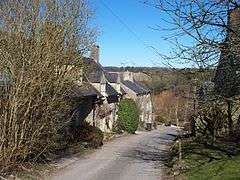Lidstone
| Lidstone | |
|---|---|
 Cottages in Lidstone | |
 Lidstone Lidstone shown within Oxfordshire | |
| OS grid reference | SP355247 |
| Civil parish | |
| District | |
| Shire county | |
| Region | |
| Country | England |
| Sovereign state | United Kingdom |
| Post town | Chipping Norton |
| Postcode district | OX7 |
| Dialling code | 01608 |
| Police | Thames Valley |
| Fire | Oxfordshire |
| Ambulance | South Central |
| EU Parliament | South East England |
| UK Parliament | |
| Website | Enstone Parish |
Lidstone is a hamlet on the River Glyme in Oxfordshire, about 3 miles (5 km) east of Chipping Norton. The hamlet is in Enstone civil parish, about 1 1⁄4 miles (2 km) west of Neat Enstone.
Archaeology
In Round Hill Field[1] on a ridge about 700 yards (640 m) south of Lidstone is a Bronze Age bowl barrow. It is 105 feet (32 m) in diameter and 2 feet (0.6 m) high. Originally it would have been substantially higher, and would have been created from spoil dug from a circular quarry trench 6 1⁄2 feet (2 m) deep. The trench has become filled in but will have survived as a buried feature. The barrow is the most northerly of a line of three that form a line between Lidstone and the village of Spelsbury. It is a scheduled monument. In the middle of the barrow is an Ordnance Survey triangulation station.[2]
Manor
By 1279 there was a hide of land at Lidstone that was part of the manor of Heythrop.[3]
Mill
Lidstone had a large watermill on the Glyme. It had the largest-diameter waterwheel in Oxfordshire: an overshot wheel 24 feet (7.3 m) in diameter[4] and 4 feet (1.2 m) wide. Via a 15-foot (4.6 m) pitwheel it drove three pairs of millstones. The mill had its own bread oven.[5] The mill was dismantled in 1976 and its machinery taken into storage, but the large iron waterwheel was left in place.[6]
References
- ↑ Harden 1954, p. 143.
- ↑ Historic England (22 March 1949). "Bowl barrow 500m south west of Hill Farm, Lidstone (1009430)". National Heritage List for England. Retrieved 1 December 2013.
- ↑ Crossley 1983, pp. 131–143
- ↑ Foreman 1983, p. 45.
- ↑ Foreman 1983, p. 111.
- ↑ Foreman 1983, plate 22.
Sources

- Crossley, Alan (ed.); Baggs, A.P.; Colvin, Christina; Colvin, H.M.; Cooper, Janet; Day, C.J.; Selwyn, Nesta; Tomkinson, A. (1983). "Heythrop". A History of the County of Oxford. Victoria County History. 11: Wootton Hundred (northern part). pp. 131–143.
- Foreman, Wilfrid (1983). Oxfordshire Mills. Chichester: Phillimore & Co Ltd. pp. 45, 111. ISBN 0-85033-441-1.
- Harden, D.B. (1954). "Scheduled Monuments in Oxfordshire". Oxoniensia. Oxford: Oxford Architectural and Historical Society. XIX: 137–145.
| Wikimedia Commons has media related to Lidstone. |
